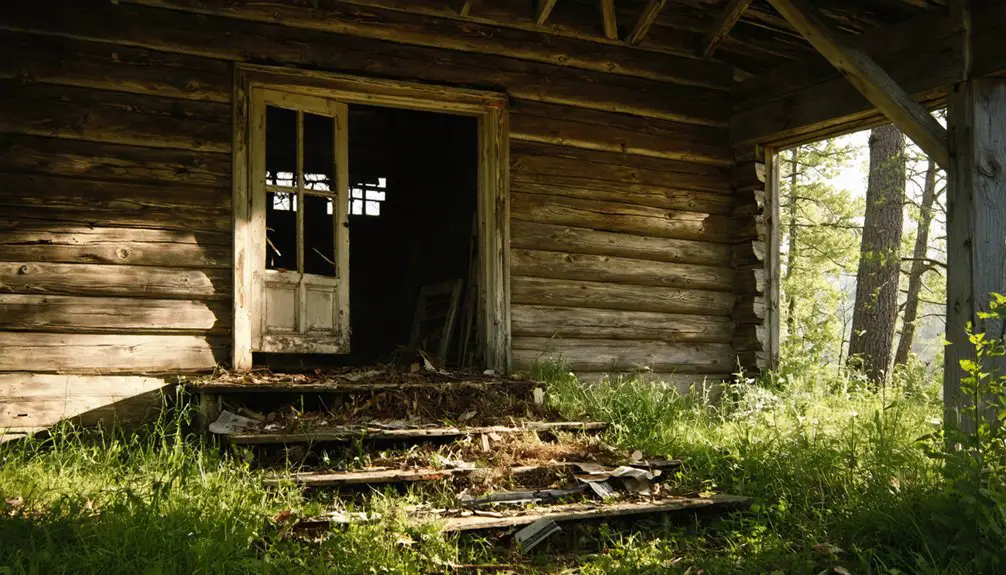Maine was the 23rd state to enter statehood on March 15, 1820.
There are 10 ghost towns in Maine.
Maine was acquired through the Missouri Compromise of 1820. The arrangement allowed Maine to join the Union as a free state; one year later, Missouri could join as a slave state. The Missouri Compromise was created to preserve the balance between free and slave states.
The first town in Maine was founded in 1623 by English settlers. Kittery is still a fully operational town with frequent tourists wanting to see the historical area.
Askwith, Maine
Askwith, Maine, now known as Terratine, was a small town in Piscataquis County. In the early 1800s, the area flourished with river fish, game animals for hunting, and timber. Starting as a small community, it quickly grew into a small town with several homes, churches, businesses, a school, a post office, and a railroad station.
The timber industry in the town offered work for lumberjacks and carpenters. Hunting and fishing offered a way to provide and trade food for goods and services needed among residents. However, every good story must have an ending, and that is what happened with Askwith.
By 1895, most of the mature lumber had been cut down, and work started to decline. At the same time, mining towns popping up in nearby areas offered other economic gains Askwith could not compete with any longer.
The post office closed later that year, in 1895. A census study from 1930 showed only 56 residents remaining in the town before finally abandoning the location a few years later. The train station that serviced the town was left in place, but the railroad was converted into an ATV trail. Terratine took Askwith’s place on maps used in present times.
Flagstaff, Maine
Until 1950, Flagstaff was the largest town in the Dead River Valley. Flagstaff, Arizona, was named after a flagstaff put up in the camp by General Benedict Arnold on an expedition to Quebec in 1775. The camp was used by British soldiers before the American Revolution and became a well-known spot throughout the late 1700s and 1800s.
In the 1840s, a grist mill and log mill were established and attracted settlers to the area. The camp began its rise to town status and soon became the largest town in the Valley. Logging was the town’s primary income source. Flagstaff remained successful until the 1940s when the Central Maine Power Company planned a power-generating dam on the Dead River and forced residents to move.
Buildings that could be moved during dam construction were relocated, some were burned down, and others were left in place. By 1950, the town had been deserted and disincorporated. The town was sacrificed and flooded to create the reservoir for the new hydroelectric power station, Flagstaff.
The remains of the town are all underwater but can be seen through glass-bottom boat tours on Flagstaff Lake for those curious about what an underwater town looks like. There have been reports regarding the “ghost of Flagstaff.” The ghost is said to be an elderly resident of the once-thriving town but refused to move before being submerged.
Perkins Township, Maine
Labeled as one of the creepiest ghost towns in Maine, Perkins Township on Swan Island is full of unanswered questions. Located in the Kennebec River, the island is only reachable by ferry, boat, canoe, or kayak. In 1763, when Thomas Handasyd Perkins paid for the town’s incorporation, the decision was made to name the township after him. Both Native Americans and settlers shared the island.
The town had a schoolhouse, a cemetery, and a town government. A population of 100 full-time residents increased during warmer months when temporary residents who built summer homes on the island would come to stay for the season. Shipbuilding, farming, and ice harvesting were popular trades in the township. However, in 1918, Perkins was disincorporated and managed by the state instead of the town.
A logical approach to why the town was abandoned would include the Great Depression of the 1940s and ongoing pollution in the Kennebec River that damaged its sustainability. Another theory is that the state bought bits of land and ultimately forced the residents to leave when all the land was purchased.
A third option is there is no exact reason why the town was abandoned. Based on the homes and furniture left behind, it appears the town was evacuated rather quickly, and residents either refused to return for their belongings or were not permitted back.
Swan Island is now part of the Steve Powell Wildlife Management Area. The area has an abundance of wildlife that can be seen when walking the trails through the forest. The homes still standing offer an eerie vision of what was left behind without an explanation. There is also a cemetery near the former Perkins Township. Camping is allowed on the island for those brave enough to stay in the vicinity of a deserted ghost town.
Riceville, Maine
Riceville was never to become an incorporated town, was a small community built around a tannery that James Rice purchased. Rice transferred land ownership to Buzzell and Rice Tanning to manufacture sole leather from buffalo hides for making shoes. After a few years, the land was transferred back to Rice from the company. Rice established a new company, Hancock Leather, and continued manufacturing sole leather.
In 1890, at the town’s high point, the population reached 136, but it did not last long. By 1900, the population dropped to 75, with 21 of those residents being students enrolled in the Riceville School. In 1905, the Hancock Leather tannery burned down, and the town’s purpose was gone, just like the building. In 1910, the census showed zero residents in Riceville.
There have been a few varieties of why the town was abandoned. The first and most believable is after the tannery burned, there was no work, so everyone left. A second theory involves the plague or a cholera epidemic that spread through the residents and left everyone dead. Two stories have circulated that could support either view of the town’s fall.
After not hearing from anyone in Riceville for quite some time, one report says that a couple traveled to the area and located several dead bodies in various places on the roads and around buildings. If a plague spread through the town, this could be possible.
A second story is from a trader who entered the town after being gone for a month, only to find the town was empty, as if it had been quickly abandoned without any official planning or notice. All that is left of Riceville are a few foundations, open wells, and random hides that can be found throughout the area.
Ligonia Village, Maine
Ligonia Village, was a community most popular with Irish families who worked for the Portland Rolling Mills company. The town had several shops, schools, and even a railway connection to Portland. As cars were introduced to the public, the railway served less purpose.
When the Portland Rolling Mills company started having more industrial competition, there was a decline in available work, and the population began to drop. The location of Ligonia has been overtaken by the Calvary Cemetery and oil companies establishing bases near the harbor area. A few pieces are left to identify the site of the former town Ligonia.
Madrid, Maine
Madrid, was established in the 1790s near the location of the former Flagstaff. Settlers purchased tracts and lots along the Sandy River, aiding in steady population growth. In 1836, the town was incorporated. Farming wheat and other crops were the town’s first resource until lumber harvesting became the primary focus.
Three sawmills, shingle machines, a gristmill, and clapboard factories further supplied the town with work and income. In 1854, gold was discovered nearby. Madrid was a hot spot on the map. With the continued increase in population, Madrid soon became home to seven schools, a rail station, a local newspaper, a hotel, multiple churches, general stores, and carriage makers.
As resources started becoming sparse, a steady decline in work and population followed. Businesses closed, residents moved, and fewer schools were needed for those families with children that remained. In 1959, the last school was closed and turned into a town hall until the town was not disincorporated in 2000. There are a few buildings still standing in the ghost town of Madrid. A schoolhouse has been turned into a town museum showcasing what life was like in the prosperous town.
Davidson, Maine
Davidson was a logging community founded in 1901. The town boasted a log mill, clothespin factory, rail station house, blacksmith shop, town hall, church, and a schoolhouse. A fun fact about the town, it had wooden sidewalks along Main Street.
Davidson was a thriving town until 1931, when the town began a slow return to nature after residents had left for an unknown reason. A few foundations and various working equipment can be located across the townsite.
Newhall, Maine
In 1824, Lester Ladlin and Edmund Fowler moved their powder production from Gambo Falls to Newhall, Maine, creating the first gunpowder mill in Maine. The two men sold their company, Gambo Mills, in 1855, and in 1859, the Oriental Powder Company continued processing gunpowder in the Newhall location. During the Civil War, the town was a primary supplier of gunpowder to the armies. Oriental Powder was one of the largest companies in Maine and the fourth-largest mill in the country.
After the Civil War ended, gunpowder demand declined, and the company temporarily switched from powder to mining and railroad construction. The Oriental Powder Company was sold to Eastern Dynamite in 1895 and sold again to the Atlas Powder Company in 1912.
Operations continued until the end of World War II. When the mill was officially closed in the late 1940s, Newhall residents relocated where work was available, eventually leaving an abandoned town. The mill, remnants of original structures, and foundations are now part of Shaw Park.
Freeman Township, Maine
Freeman Township, located near Farmington, was founded in 1797 to offer a place for Falmouth residents to resettle after their town was destroyed during the American Revolution. Falmouth was the former town of present-day Portland.
In 1775, Falmouth was burned to the ground by British bombs, and residents were left homeless. Freeman witnessed a positive boost when it reached nearly 1,000 residents in the 1840s. The township was an important trading center among farming communities.
There were two rail stations, ten schools, two churches, several general stores, and hotels. As the Industrial Revolution moved other towns forward, some were left behind and forgotten. Freeman was one of those towns left behind.
Without a specific industry to specialize in, residents were forced to work elsewhere and relocate to where jobs were available. By 1973, the town was disincorporated. Only a cemetery, a few structural remnants, and foundations remain where the township stood in previous years.
Abandoned Forts of Maine
Fort William Henry, Maine, was established in 1692 near present-day Bristol in the New Harbor village. This location saw a great deal of building and destruction throughout its early years. It was also the largest colonial fort in New England.
Before becoming Fort William Henry in 1630, Abraham Shurte’s Fort was built by British colonizers and became an important trading center before being burned by English pirates in 1633.
Fort Pemaquid was constructed where the last fort was and stood firm until 1676 when the French destroyed it during King Philip’s War.
Fort Charles took Fort Pemaquid’s place in 1677, but like its predecessors, the fort suffered significant damage and was destroyed during King Williams War in 1689.
Fort William Henry was the fourth fort to be built. Several attacks on the fort forced the British occupants to abandon the fort.
It remained empty until 1729, when a new fort, Fort Frederick, was established at the same site. In 1759, the fort was decommissioned and left deserted until it was purchased to serve as a state park in 1902.



